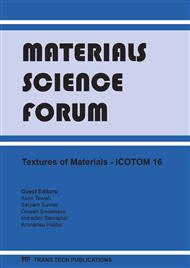p.245
p.253
p.261
p.265
p.269
p.273
p.279
p.283
p.287
Grain Orientation Spread Values in if Steels after Plastic Deformation and Recrystallization
Abstract:
From an EBSD map made on a polycrystal one can define a set of grains using a criterion of misorientation between the adjacent pixels. Once such a list of grains is obtained, various quantities can be associated to each grain such as its size, (mean) orientation, GOS (Grain Orientation Spread) etc... The GOS associated to one grain is the mean value of the misorientations between all the pixels of the grain and the mean orientation of the grain. This value is quite sensitive to the state of the material (degree of plastic deformation, degree of recrystallization for example). Therefore it can help in interpreting the evolution of a microstructure during thermomechanical treatments. It is the purpose of this presentation to provide GOS values for an IF steel after several degrees of plastic deformation as well as after several annealing treatments which lead to partially or totally recrystallized states. The sources of influence on GOS values (as grain detection limit or grain size) are analyzed. The link between the values and the state of the material will be discussed at a global stage for a given population of grains.
Info:
Periodical:
Pages:
269-272
Citation:
Online since:
December 2011
Keywords:
Price:
Сopyright:
© 2012 Trans Tech Publications Ltd. All Rights Reserved
Share:
Citation:


